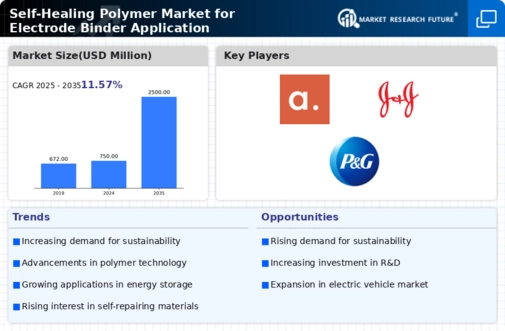Key market players are emphasizing significantly on R&D for increasing their product offerings, which will further help the Self-Healing Polymer Market for Electrode Binder Application to grow considerably. Market players are adopting several business development strategies such as acquisitions, mergers, collaborations, and partnerships to enhance their market presence and acquire a larger customer base. To survive in the competitive market, industry players must provide cost effective products.
The Self-Healing Polymer Market for Electrode Binder Application is very competitive with market players trying to develop unique and innovative products and solutions, which could render the competitors’ offerings obsolete. The competitive environment is likely to grow further owing to rising technological advancements. Some of the key players operating in the Self-Healing Polymer Market for Electrode Binder Application are BASF SE, Wacker Chemie AG (Wacker), Nanopowder Enterprises Incorporated, The Lubrizol Corporation, Nouryon, FODES, ltd, Alfa Chemistry, Arkema, SABIC, 3M. To increase their global reach and client base, key firms are concentrating on acquisitions and product innovation.
BASF SE: BASF SE is one of the leading chemical manufacturers in the world. It operates through eleven divisions that are grouped into six segments: chemicals, materials, industrial solutions, surface technologies, nutrition & care and agricultural solutions. It further manages 52 global and regional business units and develops strategies for 72 strategic business units. Company’s products find applications in a wide array of industries such as automotive, agriculture, construction, electrical & electronics, packaging, paints & coatings, textile and paper & pulp, among others.
BASF has presence in around 91 countries and facilitates the manufacturing of its products through 239 production sites spread worldwide. The company focuses substantially on research and development and had R&D spending of around USD 2.45 billion in 2022. With a strong customer base, BASF caters to around 82,000 customers from numerous sectors globally. The company primarily operates in Europe and has an active presence in the Americas, Asia-Pacific, Middle East & Africa.
Wacker Chemie AG (Wacker): Wacker Chemie AG (Wacker) is engaged in the production and distribution of specialty chemical products across the globe. It is a renowned leader in silicone products and caters to a broad range of end-use industries. The company operates through five business segments, namely, polymers, silicones, biosolutions, polysilicon, and others. It provides its range of products under acetyls, dispersible polymer powders, other silicon specialties, polysilicon, silanes, siloxanes, silicone rubber, amino acids, fine chemicals, polymer dispersion, pyrogenic silica, silicone fluids, silicone sealants, cyclodextrins, hydroxytyrosol, polymer resins, silane modified polymers, and silicon resins among others.














Leave a Comment